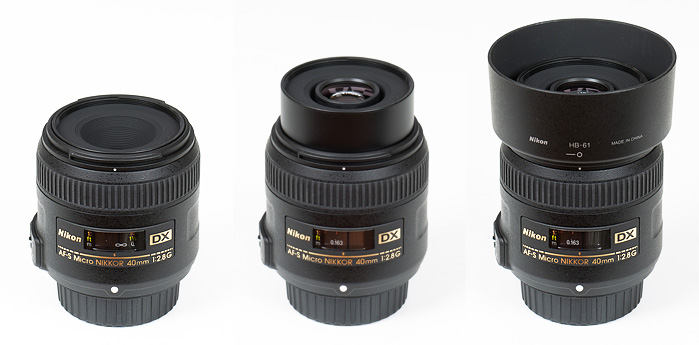|
Page 1 of 3

Review by Markus Stamm, published January 2013
Introduction
Even though Nikon continues to expand the Nikon 1 system, a native macro lens so far has not been introduced (at the time of this review).
Thanks to the existence of the FT-1 adapter however, already existing F-mount macro lenses can be used instead.
One of the most affordable and thus most attractive macro lens options is the Nikkor AF-S DX 40mm f/2.8 G lens. On Nikon 1 cameras it offers a field of view similar to a 108mm lens on full frame cameras.

The build quality of the lens is very decent thanks to an outer barrel made out of high quality plastics based on a metal mount.
The rubberized focus ring is slightly damped and operates reasonably smooth. Unfortunately the focus ring shows an issue that we have seen in several recent AF-S lenses: there's a little play when changing the focus direction in manual focus mode, which can be annoying during focus fine tuning (for example in magnified Live View mode).
The front element does not rotate so using a polarizer remains easily possible.

The lens tube extends when focusing towards closer distances. In fact there are two tubes at work, the front lens is deeply recessed at the infinity setting and moves forward to the frontmost edge of the lens tube for macro settings.
Thanks to AF-S the lens is compatible with the FT-1 adapter and features AF functionality on the Nikon 1 cameras (limited to the center AF field, though, but that's a limitation of the adapter and/or camera, not the lens). There's manual override at all times and silent operation but the AF speed is not overly fast, slower than other AF-S Micro Nikkor lenses. It's certainly fast enough for the everyday usage, however. The lens features a switch to limit the focus range from infinity to 20 cm. That may not sound like a huge gain, since the minimum focus distance of the lens is 16.3 cm, but it cuts the focus travel path in half.
Under the hood
A dedicated hood is included with the lens. For non-macro usage the hood is not really needed because of the recessed front element. For macro shots things look different and the hood certainly helps to prevent side light from hitting the front lens. In case the light is coming from behind the photographer, however, the hood easily casts a shadow on the intended subject, especially at large magnifications due to the rather short working distance. The issue is illustrated in the image below (shot with a DX camera), which is still far from 1:1.

Even with soft ambient light, lighting the subject can be really difficult when working close to the minimum focus distance. Due to the extending inner lens tube, the working distance at maximum magnification is just above 3 cm (front lens to subject, even less when taking the hood into account, too). As can be seen below, the photographed subject is darkened considerably compared to the background.

Typical for any modern Nikkor the AF-S DX 40/2.8 is a G-type lens and thus does not offer an aperture ring.
| Specifications |
|---|
| Equiv. focal length | 108 mm (full format equivalent) |
| Equiv. aperture | ≈f/7.6 (full format equivalent, in terms of depth-of-field) |
| Optical construction | 9 elements in 7 groups |
| Number of aperture blades | 7 (rounded) |
| min. focus distance | 0.163 m (max. magnification ratio 1:1) |
| Dimensions | 68.5 mm x 64.5 mm |
| Weight | 235 g |
| Filter size | 52 mm (non-rotating) |
| Hood | Nikon HB-61, barrel shaped, bayonet mount (supplied) |
| Other features | Lens provides distance (D) information to the camera, Silent Wave AF motor |
|